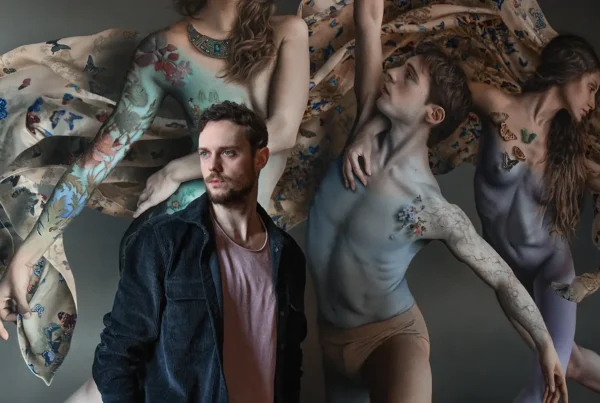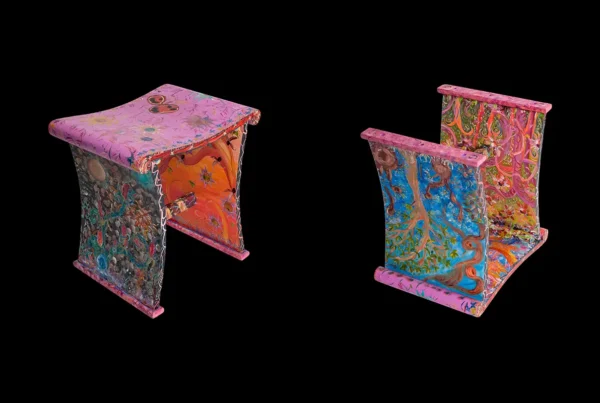“I need very little in my studio: a table, a chair, enough materials and a lockable door so that I can work undisturbed.”
From the Alps to Artistic Awakening
Pia Casanova, artistically known as Picas, embarked on her artistic journey amidst the tranquil and secluded charm of a small mountain village in Ilanz, Switzerland, where she was born on June 30, 1960. The picturesque yet secluded environment presented her with a canvas of nature’s splendor but offered little in the way of support for her burgeoning artistic ambitions. At school, her creativity was stifled by rigid exercises that demanded replication rather than imagination. Even at home, space for her artistic pursuits was scarce, relegating her to a corner of the basement after much persuasion. Undeterred, Pia began to experiment with sand and stone, laying the foundation for what would become her signature medium.
The turning point in her artistic development came between 1974 and 1976 when she met Sister Anita Derungs, an accomplished artist and graduate of the prestigious Ecole A.B.C. in Paris. Under Sister Anita’s mentorship, Pia was introduced to the fundamentals of color theory, composition, and various painting techniques, which she eagerly applied to her own work. This period was pivotal as it opened up the world of fine arts to Pia, setting her on a path to a lifelong career in art, despite the many twists and turns along the way.
From 1982 to 1986, Pia’s focus shifted to photography, particularly macro photography. This phase, however, was fraught with challenges. The delay in developing photographs and the limitations in image composition left her dissatisfied. Seeking a more immediate and tactile medium, she returned to painting, initially with vibrant acrylics that gradually became more subdued and monochromatic. It wasn’t until she revisited her childhood fascination with sand that she found her true artistic voice, leading to a unique and deeply personal technique that blends natural elements with creative expression.

Pia Casanova: Mastering the Medium of Sand
Pia’s rediscovery of sand as an artistic medium began in 2002 during walks along Swiss riverbanks. She observed the varying colors and textures of sand along the Vorderrhein River, noting how the sand transitioned from golden hues upstream to grey downstream, and from coarse grains to a fine powder. This diversity in sand characteristics inspired her to incorporate sand into her paintings, marking the beginning of her innovative technique that would come to define her work.
Her initial works, which she calls the Imaginaries, focused more on the process than the subject. By applying glue to canvas and sprinkling sand over it, Pia allowed the materials to dictate the outcome, resulting in spontaneous and abstract creations. Over time, these random motifs evolved into more structured plant and tree designs, though still grounded in imagination rather than realism. The unpredictability of working with sand and glue meant that the final results often deviated from her original vision, adding an element of surprise and serendipity to her art.
By 2013, after a decade of experimenting, Pia Casanova began translating landscapes into sand paintings. She used photographs from her walks as references, carefully applying glue and sand to capture the essence of the scenes she encountered. Her deep understanding of the medium allowed her to manipulate it precisely, achieving desired effects through controlled drying times and application techniques. This meticulous process, refined over years of practice, enabled her to create evocative landscapes that resonated with natural beauty and artistic ingenuity.

The Symbiosis of Sand and Subject
In 2021, Pia Casanova embarked on a new artistic exploration by studying 19th-century photography. She was drawn to the early photographers’ struggles with technical limitations, which paralleled her own experiences with sand. This historical perspective informed her approach to composition and subject selection, leading to a refined technique that balances modern creativity with traditional influences. It was during this period that Pia felt compelled to share her work with a broader audience, participating in digital exhibitions in Barcelona and Milan, and showcasing her art at international exhibitions in Germany and beyond. These public displays of her work earned her recognition and accolades, including the Euro Art Plaque at an exhibition in Baden-Baden.
Pia’s creative process is deeply influenced by the quality of sand, her relationship with the subject, and her mood during creation. These factors interplay to produce artworks that are both intricate and emotive. One of her most significant series, “Ils Quacs” (The Ravens), encapsulates her dual fascination with sand and ravens. The series, spanning from 2021 to 2024, features works like “Ils Nandins” and “Paul e Clau,” which use raven-black volcanic sand to depict the intelligent and majestic birds. This series exemplifies the mutual inspiration between the medium and the subject, showcasing Pia’s ability to merge her passions into cohesive and compelling art.
Pia’s approach to creating art with sand involves a delicate and deliberate technique. She collects sand from various locations, each batch bringing its own unique properties. Her process of gluing and layering sand is both meticulous and organic, allowing the natural characteristics of the sand to influence the final piece. This method not only anchors her work in the natural world but also imbues it with a sense of place and history, making each piece a testament to the landscapes and moments that inspired them.

Pia Casanova: Themes of Nature and Individuality
Pia’s work often explores the relationship between nature and individuality, particularly through her depictions of sheep. Unlike other domesticated animals, sheep are not typically subjected to factory farming due to their efficient use of sparse resources, which allows them to live more natural and social lives. Pia’s artworks, such as “Il Mantun” and “La Muntanera,” highlight the beauty and diversity within these flocks, portraying sheep as sentient beings with distinct personalities.
Her pieces juxtapose the uniformity of a flock with individual portraits, emphasizing the unique traits of each sheep. For instance, “Justina,” “Valentina,” and “Wilhelmina” are intimate depictions that capture the essence of each animal, reflecting their varying temperaments from bold to shy. Through these works, Pia challenges the perception of sheep as mere herd animals, instead presenting them as complex and relatable creatures.
Landscapes also play a significant role in Pia’s portfolio. Her pieces like “La Preid” and “La Tempesta” use mixed sands to convey themes of uncertainty and hope. These artworks depict barriers and turbulent seas that evoke a sense of mystery and anticipation. The viewer is left to wonder what lies beyond the obstacles, symbolizing the challenges and possibilities inherent in life’s journey. Pia’s landscapes are not just visual representations but are imbued with emotional depth, inviting contemplation on the part of the observer.
Pia Casanova’s art is a celebration of nature’s complexity and beauty, brought to life through her innovative use of sand. Her ability to capture the essence of her subjects, whether they are animals, landscapes, or abstract forms, speaks to her deep connection with the natural world and her mastery of her chosen medium. Through her work, she invites viewers to see beyond the surface and appreciate the intricate interplay between material and meaning.






